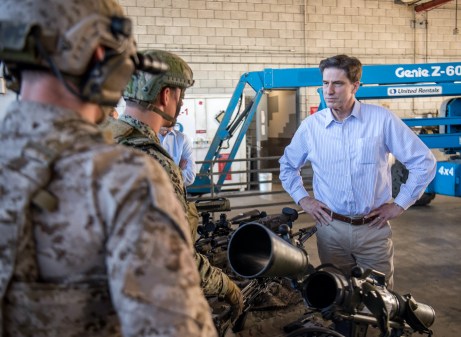For federal CIOs, telework boom shows how existing IT investments pay off in new ways

As telework has taken root during the coronavirus pandemic, federal CIOs have rapidly shifted their focus to ensure the workforce has the tools and network capacity to continue functioning as normally as possible. Although the scale-up happened suddenly, CIOs say the story started years earlier.
Agencies have been able to continue operations without major disruptions in large part because of the progress they made on IT modernization well before 2020’s global health crisis, several CIOs told FedScoop.
“We’ve been making a lot of investments across all the agencies,” Federal CIO Suzette Kent told FedScoop of recent federal IT modernization efforts — things like the adoption of cloud services, collaboration tools, digitized forms and more. “What the performance we’re seeing shows is that many of those investments are paying off.”
The Environmental Protection Agency, for instance, has been ramping up its telework-readiness over the past decade, CIO Vaughn Noga said.
“We’ve been preparing the workforce for a long time for telework. I joined the agency in 2008,” Noga said. “And over the last 12 years, we’ve been moving folks from desktops to laptops. So a good portion — 95% — of our computers are laptops.”
Preparations such as these “have put us in a position where we haven’t seen the significant IT [shifts] across the board” during the pandemic, he said. “But as this progresses, one of the things that we’re looking at is what additional resources do we need.”
“Our job is to make sure the EPA and the employees EPA can do their jobs. That’s our single focus,” Noga said.
For the last three years, the Nuclear Regulatory Commission has been locked-in on its IT modernization efforts. It has paid great dividends during the move to full-scale telework, CIO David Nelson told FedScoop.
“We went through just last year and finished up a complete refresh of all of our laptops. So everybody has new laptops with Windows 10,” Nelson said. “Two years ago, we moved up into the cloud with Office 365 and the whole set of collaborative tools. We did a voice over IP upgrade to all of our [telecom] equipment. So really we were in a pretty good place. All that planning was around both modernizing and trying to get the agency ready to really do continuity of operations which we can do operating things up in the cloud or virtually much better than it ever has before.”
Because of this, Nelson said, “we’ve been able to handle all the traffic. We pretty much have everybody in the agency working remotely. And our capacity and network are able to handle it easily.”
Processes that the average American citizen may take for granted — like moving forms to digital and enabling e-signatures — have made a world of difference in limiting personal contact during the pandemic.
To be clear, the situation hasn’t been perfect, and there have been bumps in the road for some agencies. But if some of these prior modernization efforts hadn’t happened, “we would be in a very different place,” Kent said. “We would be extremely limited, and in a pandemic situation, we would be putting people potentially in situations where person-to-person contact is critical for continuity … the investments in the citizen-facing services are helping continue continuity — telehealth, interviews on the phone, and more.”
“We were already focused on mission-critical things, but we would have been having a much more narrow conversation if we weren’t in a place to support delivery of citizen services and business exchange across the federal government in a virtual manner,” Kent said. “Modernization has paid off in this situation.”
IT modernization, accelerated
Some CIOs are using the pandemic — and, in some cases, its injection of emergency funding — as an opportunity to accelerate modernization that will stick around long after federal workers return to their desks around the nation.
“We accelerated a couple of modernization initiatives that were already underway — deployment of an electronic document routing/signature system and a new virtual collaboration tool — to enhance our distributed operating model,” National Science Foundation CIO Dorothy Aronson told FedScoop. She emphasized that the new distributed style of work “gave us an opportunity to move to a true digital signature in place of the print, sign, scan process” NSF had been using.
Even in the massive IT operating environment that is the Department of Defense, agency CIOs have been nimble in scaling up critical services in days rather than weeks and months. As each of the military services experienced triple-digit surges in teleworking, DOD CIO Dana Deasy led the department to boost its network capacity and launch the Commercial Virtual Remote (CVR) Environment, a software-as-a-service platform based on Microsoft’s Teams collaboration tool.
Deasy said the telework capabilities the DOD has developed in the past month “will be sustained at the end of COVID-19.”
The Air Force specifically has used the crisis as an opportunity to move more quickly in some areas to scale up cloud usage and supply airmen with the devices and applications they need.
“So the COVID-19 crisis, if we do this right, it allows us to address some of the digital modernization needs, the increase in mobility and cloud utilization and cybersecurity — they very much align with what we’ve already put in place. It’s just starting to accelerate,” said Bill Marion, the outgoing deputy CIO of the Air Force.
In fiscal 2020, the Army Corps of Engineers already had planned a major effort to “untether the end-user from their desktop,” CIO Dovarius Peoples said. The corps kicked off that work with fortuitous timing just as the coronavirus was beginning to spread across the globe.
The pandemic “expedited a lot of our momentum,” Peoples said. “So we are now trying to expand the digital footprint within the corps … really empowering the end-user to be able to access a lot of the mission-critical applications. …We are geographically dispersed, and having those users out in the field, being able to access their applications, being able to stand up some of the COVID-19 efforts for some of the assisted living facilities and those types of things, we’re definitely enhancing how we do business.”
Change management
Prior to the pandemic, some agencies had telework policies in place for an eligible portion of their workforces. But few if any were ready for something of this scale, leaving CIOs in late March scrambling to get personnel ready to work remotely for the foreseeable future. And though many agencies may have had the tech in place to support such a shift, the change management of it all took some extra finesse to make personnel feel comfortable.
A week before the federal government moved to mass telework to combat the spread of the coronavirus, the NRC set up a sort of IT help desk in the lobby of its Rockville, Maryland, headquarters. Nelson and his team made themselves available to answer any questions, train people on new collaboration tools and make sure NRC staff were comfortable with the unprecedented plunge into telework they were about to take.
“We focused completely on making sure any of the agency’s employees that weren’t familiar with using the new capabilities had an opportunity to come by,” Nelson said. “We would set them down and actually install things on their laptops. If they weren’t installed, things like a [virtual private network], we walk them through how they work and how to use it.”
Then, the Friday before the workforce would be told to work remotely until further notice, Nelson and his team asked NRC personnel to voluntarily telework to not only stress-test the VPN and network capacity, but also to expose any challenges that employees might face.
Fortunately, Nelson said, NRC already had the tools in place. “We just had to help people really understand how they could be used. And it’s amazing when you’re forced to use these how quickly people start to understand how to use them very efficiently. It’s just that whole change management thing — when you offer the tools, and people don’t have to use them, your adoption just kind of moves along not at a very fast pace. But when you’re just thrust into that kind of situation, people have adapted very well.”
EPA accelerated its adoption of Microsoft Teams when the pandemic hit. “We’ve engaged the workforce, and they’ve embraced working with us on trying out these new technologies,” Noga said. “And I think they recognize the situation may not be perfect and there may be lessons learned. But I would say, certainly on the IT community, they’ve embraced working with us on rolling out to new technologies.”
Before this, the historical reference point for surge capacity and shifting to telework was a severe snowstorm in the D.C. metro area, Kent said, with a few days of telework max. The comparison just isn’t close. But “now that somebody’s [teleworked], and they’ve done it every day for 30 days, it’s not scary anymore,” she said.
This crisis, Kent said, has “shown people that we can successfully work differently.”
“The federal agencies are able to stay connected to the workforce, the workforce is able to be responsive and support mission continuity,” she said. “Those are great outcomes… It’ll make both our business people inside government more comfortable with those processes. And it will demonstrate to citizens that they can still have a fulfilling, accurate, fair experience electronically.”
Ready for a different kind of normalcy
The Federal CIO Council now meets daily — compared to its regular monthly cadence — as agencies are saturated with new IT guidance on a daily basis during this novel time, Kent told FedScoop.
“We have a constant inbox and a constant dialogue going back and forth,” she said. “We’ve had guidance come out almost every single day.”
That sort of crisis communication won’t last forever. The White House issued guidance this week for how agencies should begin to shift back to working in the office. Things will at some point return to some state of normalcy; CIOs, too, will turn back to larger modernization projects they had to put aside to focus on IT services needed to support mission continuity during the pandemic.
But still, an air of uncertainty remains for what CIOs have in the days ahead of them — and how this period of time will come with lessons learned that may forever change federal technology operations.
“I think we’re over a big hump,” Kent said. “But we are going to have to look at what does business continuity look like, continue to tweak it based on the duration and the sets of activities, and however we might need to move people for activities.”
NSF’s Aronson said: “As time goes on, it is likely our needs will change, and we will have to pay attention to our next new requirement and remain agile and responsive.”
In some cases, the pandemic has obviated the IT areas that need the most support. The importance of continuity-of-operations IT support systems, telework and capacity testing has never been more apparent.
“I learned just how important it is,” Nelson said. “Our agency did take that pretty serious even before this particular event. And it’s something we’ve always done, but I can’t imagine what it’s been like for some of the private sector companies that don’t put that kind of rigor into it.”
It also showed IT officials the great partners they have in the private sector.
Based on the telework test NRC performed, “we were able to quickly put in some orders with our carriers to up our bandwidth,” Nelson said. “I’m telling you all the carriers were doing a fantastic job and they still are helping the agencies in that way. They were able to move quickly and help us put a lot more bandwidth in place.”
Kent echoed that praise: “One of the things I’ve been really happy about is that vendor partners have been incredibly responsive. They’ve been flexible. And they worked with us on solutions, not just coming to the table with, ‘Hey, here’s this thing.’”
CIOs often tend to describe modernization as a continual evolution rather than an end state. And in Kent’s case, she acknowledges that “there are still things where we need more digital capabilities. There are still opportunities to create a more resilient workforce. And those are the investments we need to continue with.”
“It took an event of forced acceptance to get comfortable” with working in this digitally-dependent manner, Kent said. “And, I only hope that we will knock out all the bad things in this situation as quickly as possible, but we’ll also take some of the learnings, the resiliency and the open eyes to what can be done in a digital and virtual environment and save those and use them as a spring for the future.”



